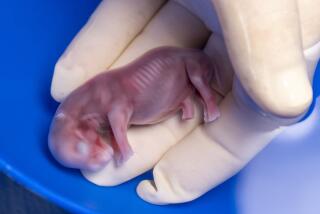In study, salmon become surrogates to endangered trout
- Share via
Papa salmon plus mama salmon equals. . . baby trout?
Japanese scientists put a new spin on surrogate parenting as they engineered one fish species to produce another, in a quest to preserve endangered fish.
Next month, Idaho scientists will try to produce sockeye salmon, highly endangered in that state, using more plentiful trout as surrogate parents.
The new method is “one of the best things that has happened in a long time in bringing something new into conservation biology,” said University of Idaho zoology professor Joseph Cloud, who is leading the U.S. government-funded sockeye project.
The Tokyo University inventors called their method “surrogate broodstocking.” They injected newly hatched but sterile Asian masu salmon with sperm-growing cells from rainbow trout -- and watched the salmon grow up to produce trout.
Conservation specialists say the technique, published in Friday’s edition of Science, is badly needed. Captive breeding of endangered fish is difficult, and attempts to freeze fish eggs for posterity have failed.
Goro Yoshizaki, a Tokyo University scientist who led the research, engineered salmon to be sterile. He then injected newly hatched salmon with stem cells destined to grow into sperm that he had culled from male rainbow trout. Once they were grown, 10 of 29 male salmon who received the injections produced trout sperm, called milt.
Here’s the bigger surprise: Injecting the male cells into female salmon sometimes worked, too, prompting five female salmon to ovulate trout eggs. That’s a scientific first, Yoshizaki said.
Then salmon-grown trout sperm were used to fertilize wild trout eggs and salmon-grown trout eggs. DNA testing confirmed that the resulting baby fish were pure trout, he reported.
More to Read
Sign up for Essential California
The most important California stories and recommendations in your inbox every morning.
You may occasionally receive promotional content from the Los Angeles Times.










